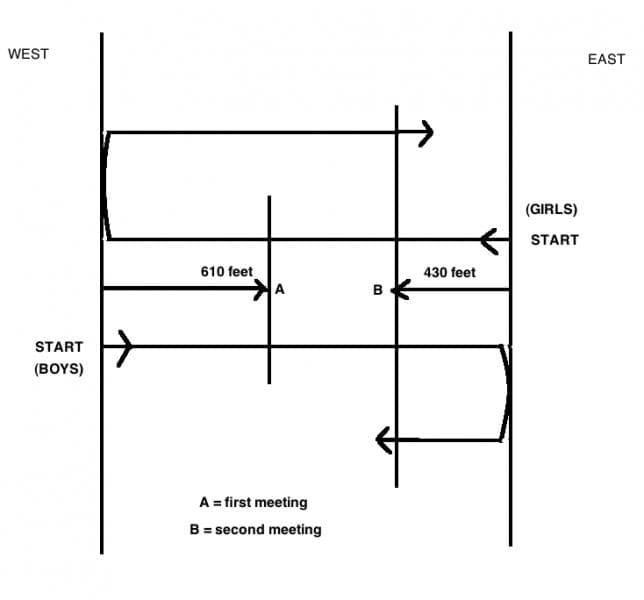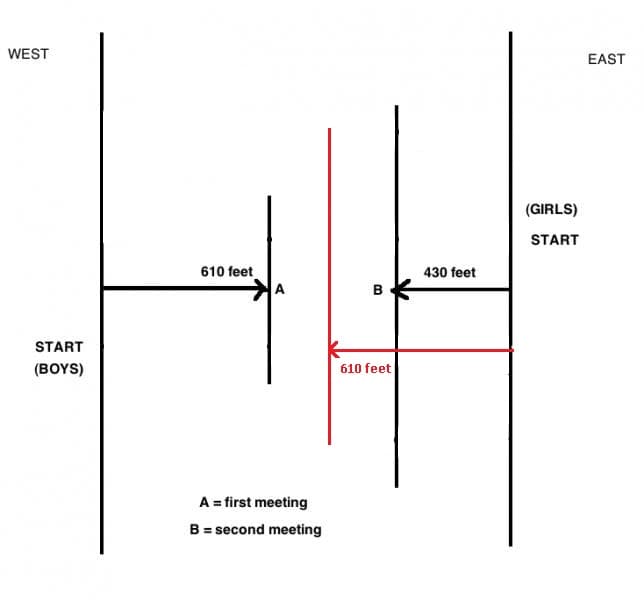Because the reason @Opti give velocity proportional to distance is wrong FOR SURE, as travel time taken is not same for both the groups.
Travel time is different, so is the distance covered at the meeting points and therefore the velocity too. But understand that no matter what the difference is, because the velocity of the boats are different from each other yet being ‘constant’ and the distance covered too being different yet constant for a given time and speed, therefore it is safe to say that time required is different but ‘constant’ too. Am not playing with definite values here. Since there is no definitive data given here, we ‘need’ to assume that velocity of the two boats were constant (doesn’t matter what values they are). If we do not make this assumption, then there will be cases with more variables than we have parameters available and the question becomes unsolvable. The assumption made by me isnt wrong.
But atleast I can not apply any mathametics / physics rule which can give me any clue that how you assumed that that distance would be thrice.
It is just a way of solving my friend, AKD solved it with a different logic, so did others. It all depends on how we started with the problem. For SS the total width of the river was divided between X dist + Y dist. For me it was X for the overall width following the logic, (X-610)+610= X. As to why is should be thrice,
“When the boats met for a second time during the homeward crossing, the total combined distance traveled would then equal three times the width of the river.
Now, when the boats first "met" on the river, the sum of distances each had traveled equals the width of the river.
When they met the second time, each boat would have traveled 3 times as far as it had traveled when they first had met.”
The quoted text and the solution image provided by AKD should be enough to understand I believe.
How can you say that the slower boat has covered 610 feet? Why can't it be the faster boat?
Ok, let it be the way you want. It doesn’t matter who is who over here. Either you make a right assumption and come onto the correct solution else make a wrong assumption and through negation or more appropriately ‘refutation’, you come to reject the assumption and derive the correct answer.
Here, she assumed it was the slower boat considering that the total width of the river was larger than atleast double of 610. I say double of 610 because, if speed of boats were having same speed and distance traveled till meeting point was 610 then total distance would be 1220. Now since the speed of one boat is faster than the other, therefore (X-610) feet is a larger distance. Therefore this 610 feet distance is covered by the slower boat as mentioned above; but with the assumption mentioned in the beginning of this paragraph. Incase the assumption comes out to be wrong in reality, the answers wouldn't change, only the cases will. Therefore no changes in values.
And when you say at the second meeting the slower boat was 430 feet from the shore, which shore do you mean?The shore from which the slower boat started or the other one? How can you be sure?
Things are best not confused here. It all depends on the logic you are trying to solve with and how you started with the question. Going through part of your answer, a part of mine and a part of AKD’s wont get us near anything than mere confusion and I believe that is what is happening here.
Honestly, AKD’s solution is a bit confusing for me and I wont comment much on the parts I don’t fully understand. But my solution was created understanding the basic velocity,dist,time being constant and solved using ratios again.
Follow my solution, logically it comes out to be the 'other' bank of the river. See next answer for more.
Then it means one boat would have reached the shore earlier and must have started their time on the shore earlier(this is regarding the 2 hour waiting period mentioned earlier).
That is the reason, in my solution, the boat(whose ever it is but slower) 1st covers 610 and meets the 2nd boat and then on its returns journey is able to cover back only 430. This is because the other faster boat has covered more distance because of its obvious faster speed. The 2 hour waiting time is being considered here but doesnt have any effect because both of them have to wait equal time and ofcourse faster boat starts off 1st and this time covers a distance of more than the earlier one due to releasing 1st from the other bank. And logically, whether given in question or not, it has to be the 'other' bank.



